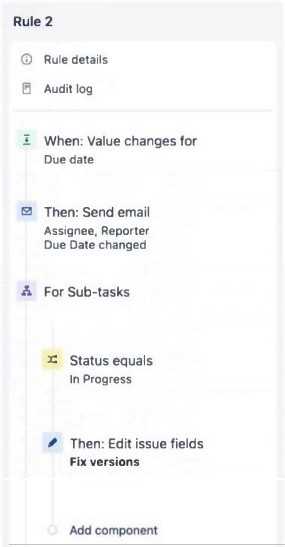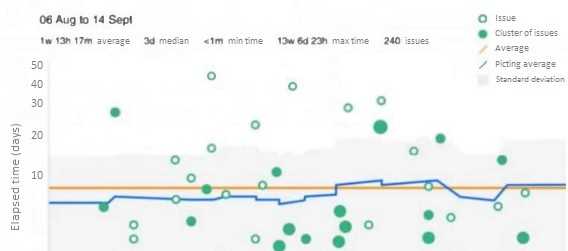atlassian ACP-620 Exam Questions
Questions for the ACP-620 were updated on : Nov 21 ,2025
Page 1 out of 4. Viewing questions 1-15 out of 56
Question 1
Team members need to indicate the affected feature when they report bugs in your company-
managed project.
● They need to select the affected feature from a dropdown list.
● They need to be able to select more than one affected feature per issue.
● Only project administrators should to be able to control and manage the feature list themselves.
Which field satisfies these requirements?
- A. Select List (single choice) custom field
- B. Select List (multiple choices) custom field
- C. labels
- D. components
Answer:
D
Explanation:
Components allow users to select multiple values from a predefined list (e.g., affected features).
They are managed by project administrators, making them ideal for controlled, multi-select
classification within a company-managed project.
Question 2
The rule shown is configured to run in your project.
The rule actor is missing a permission which is causing the rule to error.
Identify that permission.
- A. Transition Issues
- B. Modify Reporter
- C. Schedule Issues
- D. Assign Issues
- E. Resolve Issues
Answer:
C
Explanation:
The Schedule Issues permission is required to edit date-related fields, such as the Due Date and Fix
Versions. Since the rule edits the Fix versions field and responds to Due Date changes, lacking this
permission will cause the rule to fail.
Question 3
A user wants to set a field to a specific value when any issue in a project goes from the Open to
Pending status.
Identify two triggers that can be used in the automation rule. (Choose two.)
- A. field value changed
- B. Issue moved
- C. Issue created
- D. Issue transitioned
- E. scheduled
- F. branch created
Answer:
A, D
Explanation:
Field value changed: Can be used if you're targeting the Status field specifically to detect when it
changes from Open to Pending.
Issue transitioned: The most direct and reliable trigger for detecting a workflow transition from one
status (Open) to another (Pending).
Question 4
Two boards display stories from a single project.
When team members view the backlog of both boards, they can only see the Color custom field on
one of the boards and not the other.
They want to see it on both boards.
Which configuration must be changed?
- A. Field configuration
- B. Card layout
- C. Card colors
- D. Custom field context
- E. Issue layout
Answer:
B
Explanation:
The Card layout controls which fields are displayed on issue cards in the backlog and board views. To
show the Color custom field on both boards, it must be added to the card layout configuration for
each board individually.
Question 5
A team-managed project has a custom role in addition to the built-in roles.
New user Quinn needs to perform the following actions in the project:
● transition issues
● add comments
● remove watchers
● add attachments
● manage sprints
Which role will definitely grant him the permissions he needs?
- A. Viewer role
- B. Custom role
- C. Administrator role
- D. Member role
Answer:
C
Explanation:
In team-managed projects, only the Administrator role has full access to all permissions, including
advanced actions like managing sprints and removing watchers. While the Member and Custom roles
may cover some actions, only the Administrator role definitely grants all the listed capabilities.
Question 6
Which statement about custom roles in team-managed projects is true?
- A. Custom roles can only have ten or fewer permissions granted.
- B. Custom roles cannot be granted to more than one user in a project.
- C. Custom roles only exist within the single project in which they are created.
- D. Custom roles can only be used in projects with Private access.
- E. Custom roles cannot be deleted once they are in use.
Answer:
C
Explanation:
In team-managed projects, custom roles are project-specific and do not apply globally across Jira.
They are created and managed within the individual project and cannot be reused in other projects.
Question 7
You need a gadget to show only issues where status is In Progress and the assignee is the current
user viewing it.
Additionally, it should not use a saved filter and requires no additional configuration. Identify the
gadget that meets these requirements.
- A. Issue Statistics
- B. Issues In Progress
- C. Assigned To Me
- D. Activity Stream
- E. Filter Results
Answer:
B
Explanation:
The Issues In Progress gadget automatically displays issues with the status "In Progress" that are
assigned to the current user viewing the dashboard. It requires no saved filter or additional
configuration, making it the best fit for the described scenario.
Question 8
Your team wants to see the average number of days that resolved issues were open over a given
period displayed in a chart.
Which gadget meets this requirement?
- A. Resolution Time
- B. Heat Map
- C. Bubble Chart
- D. Pip chart
Answer:
A
Explanation:
The Resolution Time gadget displays the average number of days that resolved issues were open
over a specified period. It provides insights into how long issues took to resolve, aligning exactly with
the team's requirement.
Question 9
You are reviewing the Created vs. Resolved Issues Report for the last fourteen days in your project.
The report is shown.
Created issues are represented by the top line, which is red and has dots for the data points on each
day. Resolved issues are represented by the bottom line, which is green and has dots for the data
points on each day.
Which conclusion can definitely be drawn from the report?
- A. The team did not work on any issues from June 26 to June 29.
- B. There were unresolved issues in your project on June 29.
- C. 10 issues were created in the project on June 21.
- D. There was a total of only 5 unresolved issues in the project on June 20.
Answer:
B
Explanation:
On June 29, the red line (created issues) is significantly above the green line (resolved issues),
indicating that more issues were created than resolved, meaning some issues remain unresolved as
of that date.
Question 10
A shared dashboard contains the Issue Statistics gadget.
Amanda complains that the gadget displays 23 issues when she views it while other team members
report that they see 45 issues.
Select two reasons that explain why the numbers differ. (Choose two.)
- A. Some of the issues are hidden by issue security levels.
- B. She does not meet the currentUse() criteria in the saved filter.
- C. She does not have the Administer Projects permissions in some projects.
- D. She is not listed in the share settings on the saved filter.
Answer:
B
Explanation:
Some of the issues are hidden by issue security levels: Amanda may not have permission to view
issues restricted by security levels, causing her to see fewer results.
She does not meet the currentUser() criteria in the saved filter: If the saved filter uses currentUser()
in its JQL and Amanda doesn’t match its logic, the results shown to her will differ from those seen by
others.
Question 11
The Control Chart for the Orange team board is shown.
What two items can you interpret from this report? (Choose two.)
- A. Issues in the report use time-based estimation.
- B. The fastest time any issue transitioned to done was less than one minute.
- C. The team slowly became faster at transitioning issues to done.
- D. Issues on average take over one week to transition to done.
- E. The team's cycle time is slowly becoming more predictable.
Answer:
B, D
Explanation:
The minimum time shown is <1 minute, which indicates the fastest an issue transitioned to done.
The average time shown is 1w 13h 17m, which confirms that on average, issues take over one week
to complete.
Question 12
You need to write a JQL query showing:
● issues where the Priority was High in the past and may or may not still be High
Identify two JQL statements that will return the correct results. (Choose two.)
- A. priority was High OR priority = High OR priority != High
- B. priority was High AND priority = High AND priority != High
- C. priority changed to High before now()
- D. priority was High
- E. priority was High AND (priority = High OR priority != High)
Answer:
C, D
Explanation:
priority changed to High before now(): This returns issues where the priority was set to High at any
point in the past, regardless of its current value.
priority was High: This returns issues that had High priority at some point, whether or not they still
have it. Both satisfy the requirement to show issues where the priority was High in the past and may
or may not still be.
Question 13
You want to see how unresolved issues are trending over a given period. Namely, on any given day,
what is the average amount of time that issues were still unresolved.
What gadget displays this information?
- A. Average Number of Times in Status
- B. Average Age Chart
- C. Average Times in Status
- D. Resolution Time
Answer:
B
Explanation:
The Average Age Chart shows the average age of unresolved issues over time. It helps visualize how
long, on average, issues have been open on any given day, which directly reflects how unresolved
issues are trending.
Question 14
A user wants to add the label VIP to an issue when any member of the Executives group adds a
comment to it.
The configuration of the automation rule is shown.
The automation rule does not always execute as expected.
What is the cause of the problem?
- A. The label VIP is not available in the issue's project.
- B. User condition has to be the trigger.
- C. A condition is missing to check whether the label is already set.
- D. User condition does not account for who is commenting.
- E. Issue commented has to be the condition.
Answer:
D
Explanation:
The user condition is checking whether the reporter is in the Executives group, but the rule is
triggered when the issue is commented on. To work as intended, the condition should check whether
the commenter (i.e., user who triggered the rule) is in the Executives group - not the reporter.
Question 15
You need to write a JQL query that returns all issues without the label "discard".
Identify the JQL statement that returns the correct results.
- A. labels != discard OR labels is EMPTY
- B. labels in (discard, EMPTY)
- C. label!- discard
- D. labels != discard
- E. labels not in (discard, NULL)
Answer:
A
Explanation:
This JQL correctly returns all issues that do not have the label "discard", including those where the
labels field is empty. Without the OR labels is EMPTY clause, issues with no labels would be excluded.